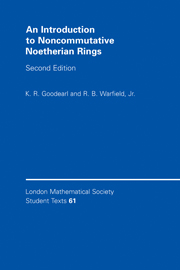Book contents
- Frontmatter
- Contents
- Introduction to the Second Edition
- Introduction to the First Edition
- Prologue
- 1 A Few Noetherian Rings
- 2 Skew Polynomial Rings
- 3 Prime Ideals
- 4 Semisimple Modules, Artinian Modules, and Torsionfree Modules
- 5 Injective Hulls
- 6 Semisimple Rings of Fractions
- 7 Modules over Semiprime Goldie Rings
- 8 Bimodules and Affiliated Prime Ideals
- 9 Fully Bounded Rings
- 10 Rings and Modules of Fractions
- 11 Artinian Quotient Rings
- 12 Links Between Prime Ideals
- 13 The Artin-Rees Property
- 14 Rings Satisfying the Second Layer Condition
- 15 Krull Dimension
- 16 Numbers of Generators of Modules
- 17 Transcendental Division Algebras
- Appendix. Some Test Problems for Noetherian Rings
- Bibliography
- Index
9 - Fully Bounded Rings
Published online by Cambridge University Press: 11 November 2010
- Frontmatter
- Contents
- Introduction to the Second Edition
- Introduction to the First Edition
- Prologue
- 1 A Few Noetherian Rings
- 2 Skew Polynomial Rings
- 3 Prime Ideals
- 4 Semisimple Modules, Artinian Modules, and Torsionfree Modules
- 5 Injective Hulls
- 6 Semisimple Rings of Fractions
- 7 Modules over Semiprime Goldie Rings
- 8 Bimodules and Affiliated Prime Ideals
- 9 Fully Bounded Rings
- 10 Rings and Modules of Fractions
- 11 Artinian Quotient Rings
- 12 Links Between Prime Ideals
- 13 The Artin-Rees Property
- 14 Rings Satisfying the Second Layer Condition
- 15 Krull Dimension
- 16 Numbers of Generators of Modules
- 17 Transcendental Division Algebras
- Appendix. Some Test Problems for Noetherian Rings
- Bibliography
- Index
Summary
One major obstacle to adapting commutative noetherian ring theory to the noncommutative case in general is the lack of ideals. For example, the Weyl algebras over division rings of characteristic zero are simple noetherian domains, yet their module structure is quite complicated. Thus, to derive much structure theory similar to the commutative theory, one should work in a context where a large supply of ideals is guaranteed. One such context is introduced and investigated in this chapter. The results obtained may serve to give a sample of what is known about noetherian rings satisfying a polynomial identity (P.I.), although the methods used are very different from those of P.I. theory.
• BOUNDEDNESS •
Definition. A ring R is right bounded if every essential right ideal of R contains an ideal which is essential as a right ideal.
For instance, every commutative ring is right bounded, as is every semisimple ring (since a semisimple ring has no proper essential right ideals). On the other hand, a simple ring cannot be right bounded unless it is artinian. Note that a prime ring R is right bounded if and only if every essential right ideal of R contains a nonzero ideal (recall Exercise 5A).
Definition. A ring R is right fully bounded provided every prime factor ring of R is right bounded.
Information
- Type
- Chapter
- Information
- An Introduction to Noncommutative Noetherian Rings , pp. 156 - 165Publisher: Cambridge University PressPrint publication year: 2004
